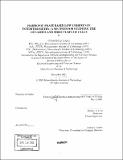Harmonic phase based low coherence interferometry : a method for studying the dynamics and structures of cells
Author(s)
Yang, Changhuei, 1972-
DownloadFull printable version (17.38Mb)
Other Contributors
Massachusetts Institute of Technology. Dept. of Electrical Engineering and Computer Science.
Advisor
Michael S. Feld.
Terms of use
Metadata
Show full item recordAbstract
(cont.) Using this method, it is possible to determine the refractive index of a 1 mm thick sample with 7 significant figures. The unprecedented accuracy can potentially allow us to track subtle chemical changes in biological targets. Finally, we present the theoretical considerations of a method for suppressing turbidity in a scattering medium through the simultaneous use of phase conjugation and plane reflection. We show that the method is robust and warrants experimental investigation as a means for optical deep tissue imaging. We report a novel optical imaging method based on the use of harmonically related light sources in a low coherence interferometer - harmonic phase-based low coherence interferometry (HPI). We demonstrate that, by processing the measured heterodyne phases appropriately, we can completely correct for motional jitter in the interferometer, which would otherwise make phase determination impossible. We apply the interferometer to study the phase velocity variation of ballistically propagating light traveling in a turbid medium and show that the phase velocity is dependent on the size of the scatterers. We next create a microscopy implementation of HPI. By exploiting the refractive index difference at the two wavelengths for contrast, the microscope is able to render details from unstained microscope sections based on their refractive index variations. We then exploit the property of low coherence interferometry to achieve depth resolution in our next adaptation of HPI - phase dispersion optical tomography. There, we demonstrate the ability to measure the reflection phase shift which can be used to determine properties of the reflecting materials. In addition, the technique can provide depth resolved dispersion information about a sample. We next apply HPI to tackle the challenge of tracking very small ([approx.] nm) arid very slow ([approx.] nm/s) cellular motions. Using a modified HPI system, we can study the cell membrane dynamics of a single cell without destroying it in the process. This system is about 2 orders of magnitude more sensitive than existing systems. In the final adaptation of the HPI, we demonstrate that HPI can be used to make absolute optical distance measurements with sub-nanometer accuracy.
Description
Thesis (Ph.D.)--Massachusetts Institute of Technology, Dept. of Electrical Engineering and Computer Science, February 2002. Includes bibliographical references.
Date issued
2002Department
Massachusetts Institute of Technology. Department of Electrical Engineering and Computer SciencePublisher
Massachusetts Institute of Technology
Keywords
Electrical Engineering and Computer Science.